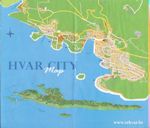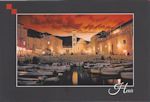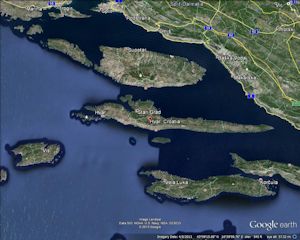

Image from Wikipedia
Links to Port Pages
Hvar, Croatia
The Silver Wind anchored outside of Hvar early in the morning. We decided this port would be our "rest day" before arriving in Venice so we slept in a bit and had a late breakfast. We were enjoying a coffee out on the pool deck when Captain Palmieri came off the bridge for his morning coffee and joined us. We had a great time discussing the cruise so far, a bit about our lives and his, and just an enjoyable "get to know each other better" conversation.
We tendered off the ship around 11 am and wandered the small town. Hvar is known for sunshine and lavender. The local area is very small, so it was easy to walk around. We then enjoyed a cappuccino at an outdoor cafe in St Strjepana (Stephen) Square by the cathedral.
A few pictures, some lavender and we headed back to the ship as we left Hvar at 3pm headed to Venice!
Arriving Hvar Island |
Silver Wind anchored off Hvar |
Carey - Hvar |
Randy - Hvar |
St Stjepana (Stephen) Square - Hvar The square umbrellas are where we enjoyed a cappuccino at an outdoor cafe |
Steps Walkway in Hvar |
Leaving Hvar |
Hvar Map |
Postcard - St Stjepana at night |
Postcard - Lavender Fields |
![]()
Pre-cruise Posts
 |
Hvar (pronounced [xv̞âːr]; local Chakavian dialect: Hvor or For, Greek: Pharos, Φάρος, Latin: Pharia, Italian: Lesina) is a Croatian island in the Adriatic Sea, located off the Dalmatian coast, lying between the islands of Brač, Vis and Korčula. Approximately 68 km (42.25 mi) long, with a high east-west ridge of Mesozoic limestone and dolomite, the island of Hvar is unusual in the area for having a large fertile coastal plain, and fresh water springs. Its hillsides are covered in pine forests, with vineyards, olive groves, fruit orchards and lavender fields in the agricultural areas. The climate is characterized by mild winters, and warm summers with many hours of sunshine. The island has 11,103 residents, making it the 4th most populated of the Croatian islands.
Hvar’s location at the center of the Adriatic sailing routes has long made this island an important base for commanding trade up and down the Adriatic, across to Italy and throughout the wider Mediterranean. It has been inhabited since pre-historic times, originally by a Neolithic people whose distinctive pottery gave rise to the term Hvar Culture, and later by the Illyrians. The ancient Greeks founded the colony of Pharos in 384 BC on the site of today’s Stari Grad, making it one of the oldest towns in Europe. They were also responsible for setting out the agricultural field divisions of the Stari Grad Plain, now a UNESCO World Heritage Site. In medieval times, Hvar (city) rose to importance within the Venetian Empire as a major naval base. Prosperity brought culture and the arts, with one of the first public theatres in Europe, nobles’ palaces and many fine communal buildings.
The 16th century was an unsettled time, with the Hvar Rebellion, coastal raids by pirates and the Ottoman army from the mainland, resulting in some unusual fortified buildings on the northern shore to protect the local population. After a brief time under Napoleonic rule, the island became part of the Austrian Empire, a more peaceful and prosperous time. On the coast, harbours were expanded, quays built, fishing and boat building businesses grew. At the same time, the island’s wine exports increased, along with lavender and rosemary production for the French perfume industry. Unfortunately, this prosperity did not continue into the 20th century as wooden sailing boats went out of fashion, and the phylloxera blight hit wine production. Many islanders left to make a new life elsewhere.
One industry, however, has continued to grow and is now a significant contributor to the island’s economy. The formation of The Hygienic Association of Hvar in 1868 for the assistance of visitors to the island has been instrumental in developing an infrastructure of hotels, apartments, restaurants, marinas, museums, galleries and cafes. Today, the island of Hvar is a popular destination for tourists, consistently listed in the top 10 islands by Conde Nast Traveler magazine. (From Wikipedia)
![]()
What We Plan to See:
Hvar is an island off the Dalmatian coast. This could be a day to walk and explore as it had been a naval base for the Venetian Empire.
![]()


















